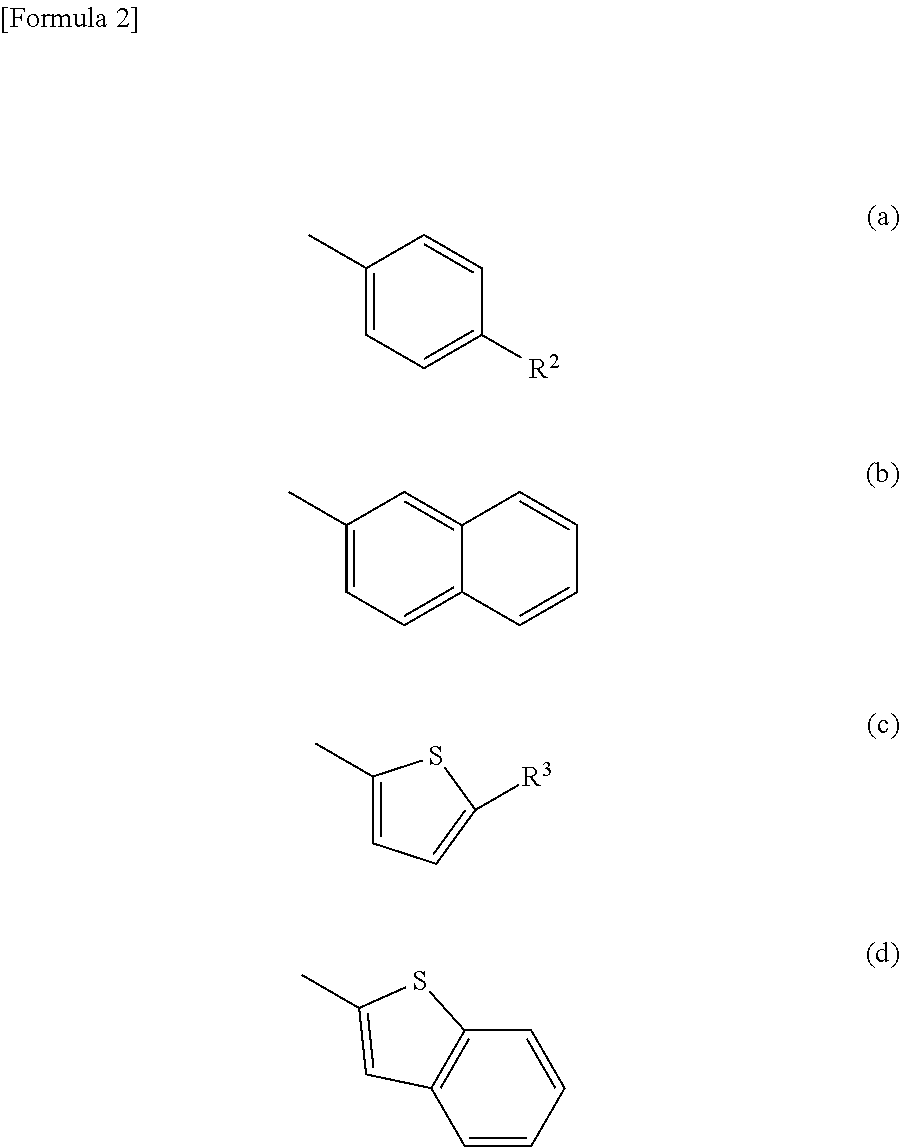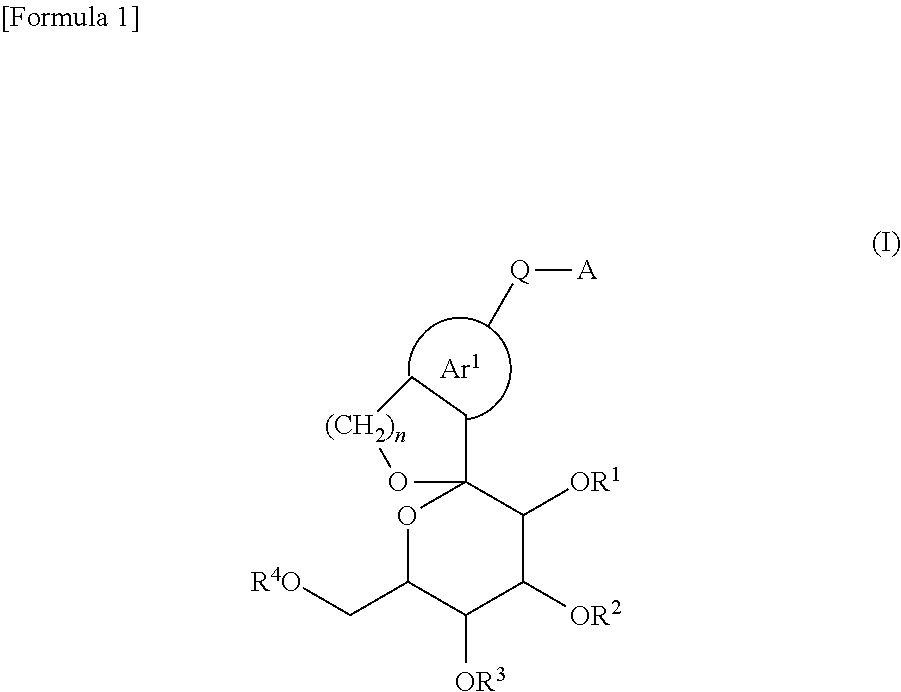Substituted spiroketal derivatives and use thereof as therapeutic drug for diabetes
a technology of spiroketal derivatives and substituted spiroketal, which is applied in the field of spiroketal derivatives, can solve the problems of aggravating symptoms, immediate disappearance of pharmacological effects, and increase of blood sugar level
- Summary
- Abstract
- Description
- Claims
- Application Information
AI Technical Summary
Benefits of technology
Problems solved by technology
Method used
Image
Examples
example 1
(1S,3′R,4′S,5′S,6′R)-5-chloro-6-[(4-ethylphenyl)methyl]-3′,4′,5′,6′-tetrahydro-6′-(hydroxymethyl)-spiro[isobenzofuran-1(3H),2′-[2H]pyran]-3′,4′,5′-triol
[0251]
1) Synthesis of (4-acetoxymethyl-2-bromo-5-chloro)benzyl acetate
[0252]To a solution (45 mL) of 1-bromo-4-chloro-2,5-dimethylbenzene (10.0 g, 45.5 mmol) in ethyl acetate was added N-bromosuccinimide (21.0 g, 118.4 mmol) and 2,2′-azobis(isobutyronitrile) (300 mg), and the resultant mixture was stirred for 20 minutes at 100 to 120° C. The reaction mixture was cooled to room temperature and then ethyl acetate was added thereto. The resultant mixture was then successively washed with water and saturated brine. The organic layer was dried over anhydrous magnesium sulfate, and the solvent was then removed by distillation under reduced pressure. The obtained crude product (20.8 g) was dissolved in DMF (100 mL), and sodium acetate (11.2 g, 136.5 mmol) was added thereto. The resultant mixture was stirred for 3 hours at 80° C. The reactio...
reference example 1
Synthesis of 4-(2-fluoroethyl)phenylboronic acid
[0267]
[0268]Under a nitrogen stream, to a solution of 1-bromo-4-(2-fluoroethyl)-benzene (Tetrahedron: Asymmetry, 1993, 4(10), page 2183) (412 mg, 2.03 mmol) in THF (9 mL) was added a solution of n-butyllithium in n-hexane (2.71 M, 0.87 mL, 2.36 mmol) at −78° C., and the resultant mixture was stirred at the same temperature for 0.5 hours. Trimethoxyborane (0.36 mL, 3.21 mmol) was added thereto, and the resultant mixture was stirred at room temperature for 4.5 hours. Then, to the solution was added 20% hydrochloric acid, and the resultant mixture was extracted 3 times with methylene chloride. The organic layer was concentrated under reduced pressure. The resulting residue was purified by silica gel flash column chromatography (developing solvent=ethyl acetate:n-hexane (1:1)), to thereby obtain the titled compound (216 mg, 63%).
[0269]1H-NMR (CDCl3) δ: 2.99-3.18 (2H, m), 4.55-4.80 (2H, m), 7.28-8.19 (4H, m).
[0270]The compounds listed in Ta...
example 16
(1S,3′R,4′S,5′S,6′R)-6-[(4-ethylphenyl)methyl]-5-fluoro-3′,4′,5′,6′-tetrahydro-6′-(hydroxymethyl)-spiro[isobenzofuran-1(3H),2′-[2H]pyran]-3′,4′,5′-triol
[0271]
1) Synthesis of 5-bromo-2-fluoro-4-(hydroxymethyl)benzaldehyde
[0272]Tetramethylpiperidine (0.68 g, 4.87 mmol) was dissolved in tetrahydrofuran (4.5 mL). To the resultant solution was added n-butyllithium (1.0 M n-hexane solution, 4.88 mL) at 0° C., and this solution was stirred for 15 minutes. The resultant mixture was cooled to −78° C. and a solution of (2-bromo-5-fluorophenyl)methanol (0.50 g, 2.43 mmol) in tetrahydrofuran (2.5 mL) was added dropwise thereto. The temperature of the solution was raised over 2 hours to −40° C. The solution was again cooled to −78° C., and then dimethylformamide (0.47 mL, 6.07 mmol) was added thereto. The temperature of the solution was raised to room temperature, and the solution was stirred for 30 minutes. Saturated aqueous ammonium chloride was then added thereto, and the resultant mixture wa...
PUM
| Property | Measurement | Unit |
|---|---|---|
| Molar density | aaaaa | aaaaa |
| Molar density | aaaaa | aaaaa |
| Molar density | aaaaa | aaaaa |
Abstract
Description
Claims
Application Information
 Login to View More
Login to View More - R&D
- Intellectual Property
- Life Sciences
- Materials
- Tech Scout
- Unparalleled Data Quality
- Higher Quality Content
- 60% Fewer Hallucinations
Browse by: Latest US Patents, China's latest patents, Technical Efficacy Thesaurus, Application Domain, Technology Topic, Popular Technical Reports.
© 2025 PatSnap. All rights reserved.Legal|Privacy policy|Modern Slavery Act Transparency Statement|Sitemap|About US| Contact US: help@patsnap.com



